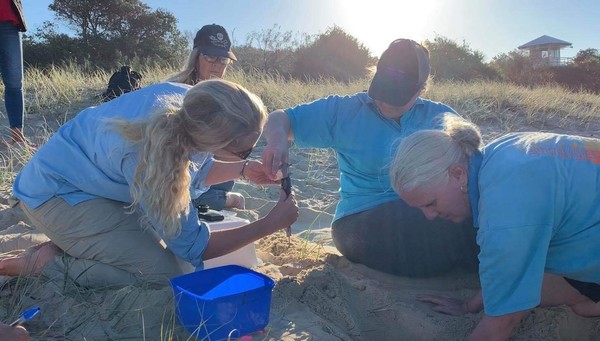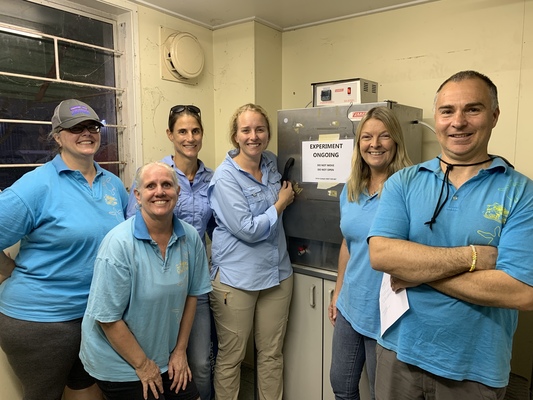
Just after 7am on Monday morning, July 22, Sunshine Coast Council Conservation Officer Kate Hofmeister got an unexpected call about an unusual sighting on the beach of Mudjimba.
Shortly after, Ms Hofmeister arrived onsite with volunteers from Coolum & North Shore Coast Care where they identified tracks in the sand as those of an endangered Loggerhead female turtle.
An experienced Coolum & North Shore Coast Care volunteer, Sherida Holford, then found something truly surprising, an out-of-season turtle nest which Ms Hofmeister believes is the first recorded during a winter season along the coast.
“An out-of-season Loggerhead nest is scientifically remarkable,” Ms Hofmeister said.
“Due to the unique nature of the nest being outside of season and the first on record along the coast, perhaps even for the entire East Coast Loggerhead population, the State Government asked that we incubate the clutch.”
A clutch refers to the nest of eggs, and as council’s TurtleCare program operates under a permit from the Department of Environment and Science, the team immediately sought direction from the State Government’s top turtle researcher, Dr Col Limpus.
Kate’s colleague Dr Simone Bosshard shared the advice from Dr Limpus of how they would proceed with this unusual finding.
“Dr Limpus recommended incubation to see if the eggs are viable,” said Dr Bosshard.
“We don’t yet know if they’ve been fertilised because this clutch is so out of cycle.
“A few days after being laid, part of the embryonic tissue grows out and spreads under the shell. This tissue is a gas exchange membrane called chorion, and results in a distinct white spot on the eggshell.
“So in just a few days, we will look for that white spot, indicating whether an egg is viable or not.”
Prior to checking if they are viable, the team needed to transfer the eggs from their sandy nest to a safe, climate-controlled incubator.
Council officers quickly arranged to borrow the State Government’s incubator, which had previously been used at the Queensland Museum in South Brisbane.
On Tuesday afternoon, 23 July, again with Coolum & North Shore Coast Care volunteers who have been integral to this process, the team carefully transferred the clutch’s 93 eggs to containers prepared with moist sand.
They then carefully transported the containers by vehicle to council’s Maroochydore Depot where finally the eggs were successfully transferred to the incubator.
Ms Hofmeister explained the coordinated choreography of the transition.
“The reason for the careful transfer is that movement can induce mortality in turtle eggs when moved at this early time,” Ms Hofmeister said.
“However, if they remain in the sand for a further 48 hours, they would all perish due to the cold temperatures.
“They will now remain in the incubator for the next several weeks, with daily checks by the team.”
Dr Bosshard added that the incubator is kept at a strategic temperature.
“Again, per advice from Dr Limpus, the incubator is being maintained between 29.5 and 29.9 degrees,” Dr Bosshard said.
“This is in the hopes that this ideal incubation temperature will help produce strong, robust female hatchlings.
“If we’re lucky enough, once all the hatchlings are out of their eggs, they will then be released back at Mudjimba Beach to start their long journey in the ocean.”
In the meantime, Coolum & North Shore Coast Care and TurtleCare volunteers continue to keep an eye on the shores to see if this special female Loggerhead returns to lay another clutch of eggs.
These turtles usually return within a 14-18 day period, however due to the colder water, it is anticipated she may take a little longer in this internesting period.
If anyone sees turtle tracks on the beach, please do not disturb the area and ring the TurtleCare hotline on 0437 559 067.






